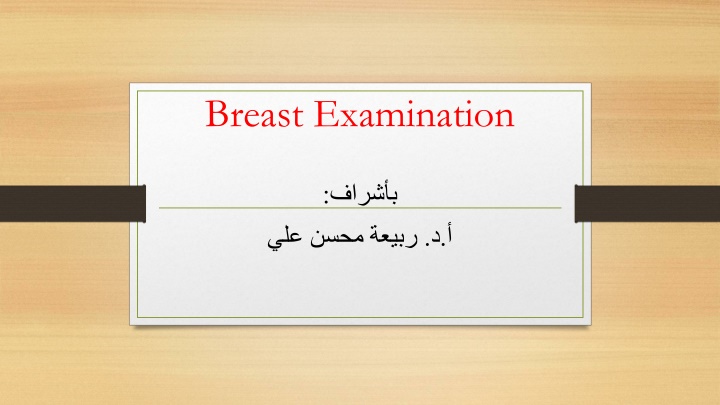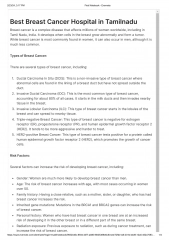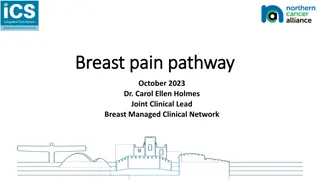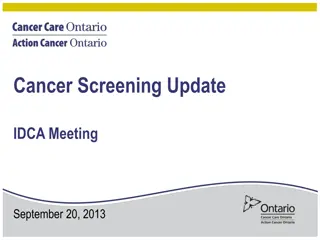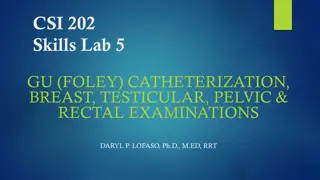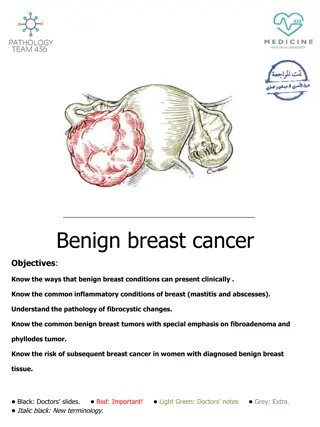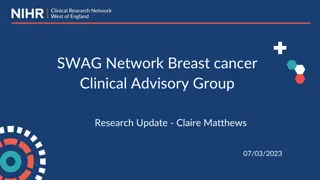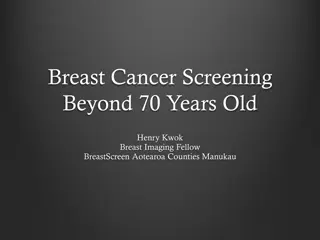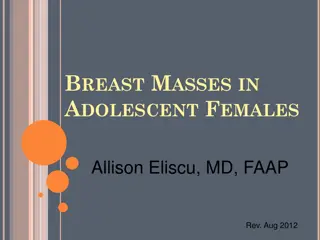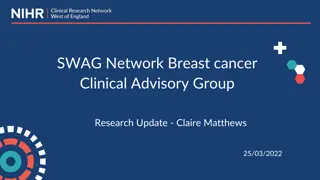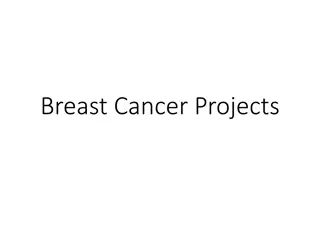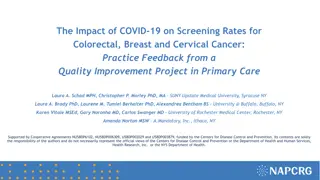Comprehensive Guide to Breast Examination and Screening
Breast health is crucial for every woman, and regular breast examinations play a significant role in early detection of abnormalities and breast cancer. This comprehensive guide covers different screening methods, assessment interviews, clinical breast examinations, and what to look for during a breast examination. It emphasizes the importance of self-awareness and regular screenings to ensure optimal breast health.
Download Presentation

Please find below an Image/Link to download the presentation.
The content on the website is provided AS IS for your information and personal use only. It may not be sold, licensed, or shared on other websites without obtaining consent from the author.If you encounter any issues during the download, it is possible that the publisher has removed the file from their server.
You are allowed to download the files provided on this website for personal or commercial use, subject to the condition that they are used lawfully. All files are the property of their respective owners.
The content on the website is provided AS IS for your information and personal use only. It may not be sold, licensed, or shared on other websites without obtaining consent from the author.
E N D
Presentation Transcript
Breast Examination : . .
THE BREAST It has an important role in modern culture Often viewed as measures of sexuality , femininity and attractiveness because it is visible for its size and shape. However, it is a secondary sex characteristic Its physiologic function is milk secretion to feed infants
Screening for Breasts: 1. Clinical Breast Examination (CBE) 2. Self-Awareness (Monthly Self-Exams) (BSE) 3. Fine Needle Aspiration ( FNA) 4. Mammograms
Assessment interview Breast History Ask the client about breast pain or tenderness and its occurrences in relation to menstrual cycle. Ask whether the woman has had in the past or currently has breast lumps or masses. If a lump is present, ask the woman to describe its location, onset and size and whether it is painful Determine whether the lump has changed shape, size, consistency, or degree f redness since it was first noticed
Ask about nipple discharge, which is abnormal in women who are not pregnant or lactating. If there is a discharge, determine the color, consistency, amount and odor. Ask whether the woman perform BSE regularly Note whether the woman include axillary nodes in BSE Ask for her HISTORY of breast cancer in her blood-related FEMALE relatives mother, sisters, maternal grandmother or maternal aunts. It indicates an increased risk of breast cancer if she has any family history of breast cancer
Clinical Breast Examination: A clinical breast exam is performed by a healthcare professional who is trained to recognize many different types of abnormalities and warning signs. Preparation 1. The student should introduce him or herself to the patient, confirm the patient s name and how she wants to be addressed. 2. The student should wash hands with soap and warm water and dry with a towel or alcohol based antiseptic. 3. The student should inform the patient that he/she is performing a breast exam. This is a good time to ask the patient if she has noticed any lumps or other problems with her breasts.
In breast examination the student should be looking for: Breasts that are their usual size, shape, and color Breasts that are evenly shaped without visible distortion or swelling Dimpling, puckering, or bulging of the skin A nipple that has changed position or an inverted nipple (pushed inward instead of sticking out) or any discharge Redness, soreness, rash, or swelling
Inspection Give a brief overview of examination to patient. Have the patient sit at end of exam table. Ask the patient to remove gown to her waist, assist only if needed. Have the patient relax arms to her side. Examine visually for following: _ Approximate symmetry Dimpling or retraction of skin Swelling or discoloration Orange peel effect on skin Position of nipple
Palpation Technique in Detail a. Use the pads of the middle 3 fingers of one hand. b. Press downward using a circular motion. c. Apply steady pressure, pushing down to the level of the chest wall. d. Make sure to palpate the nipple and areolar regions.
Palpation Have the patient lie supine on the exam table. Ask the woman to remove the gown from one breast and place her hand behind her head on that side. Begin to palpate at junction of clavicle and sternum using the pads of the index, middle, and ring fingers. If open sores or discharge are visible, wear gloves. Press breast tissue against the chest wall in small circular motions. Use very light pressure to assess superficial layer, moderate pressure for middle layer and firm pressure for deep layers.
Palpate the breast in overlapping vertical strips. Continue until you have covered the entire breast including the axillary "tail." Palpate around the areola and the depression under the nipple. Press the nipple gently between thumb and index finger and make note of any discharge. Lower the patient's arm and palpate for axillary lymph nodes. Have the patient replace the gown and repeat on the other side. Reassure the patient, discuss the results of the exam. Begin by looking at breasts in the mirror with shoulders straight and arms on hips.
Here's what should look for: Breasts that are their usual size, shape, and color. Breasts that are evenly shaped without visible distortion or swelling. If see any of the following changes, bring them to the doctor's attention: Dimpling, puckering, or bulging of the skin. A nipple that has changed position or become inverted (pushed inward instead of sticking out).Redness, soreness, rash, or swelling
Signs Of Breast Cancer Elevation Asymmetry Bleeding Orange Peel skin Nipple Retraction
Women are screened for breast cancer in 3 ways: 1-Mammography: roentgenography of breasts without injection of contrast medium. It is most sensitive. 3 views : Craniocaudally Medio lateral Axillary
2. Clinical Breast Examination : clinical breast exam is an examination by a doctor or nurse, who uses his or her hands to feel for lumps or other changes 3. Breast self-exam: A breast self-exam is when you check your own breasts for lumps, changes in size or shape of the breast, or any other changes in the breasts or underarm (armpit).
References K sters JP, G tzsche PC (2003). K sters, Jan Peter (ed.). "Regular self-examination or clinical examination for early detection of breast cancer". Cochrane Database Syst Rev (2): CD003373. doi:10.1002/14651858.CD003373. PM 7387360. ^ Thomas DB, Gao DL, Ray RM, et al. (2002). "Randomized trial of breast self-examination in Shanghai: final results". J. Natl. Cancer Inst. 94 (19): 1445 57. doi:10.1093/jnci/94.19.1445. PMID 12359854. ^ Harris R, Kinsinger LS (2002). "Routinely teaching breast self-examination is dead. What does this mean?". J. Natl. Cancer Inst. 94(19): 1420 1. doi:10.1093/jnci/94.19.1420. PMID 12359843
